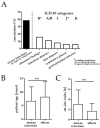Factors Influencing the Frequency of Airway Infections in Underage Refugees: A Retrospective, Cross Sectional Study
- PMID: 32962038
- PMCID: PMC7557950
- DOI: 10.3390/ijerph17186823
Factors Influencing the Frequency of Airway Infections in Underage Refugees: A Retrospective, Cross Sectional Study
Abstract
Background: Infections are a leading cause of refugee morbidity. Recent data on the rate of airway infections and factors influencing their spread in refugee reception centers is scarce. Methods: A retrospective, cross-sectional study of de-identified medical records with a focus on respiratory infections in underage refugees was conducted at two large German refugee reception centers. Results: In total, medical data from n = 10,431 refugees over an observational period of n = 819 days was analyzed. Among pediatric patients (n = 4289), 55.3% presented at least once to the on-site medical ward with an acute respiratory infection or signs thereof. In 38.4% of pediatric consultations, acute airway infections or signs thereof were present. Airway infections spiked during colder months and were significantly more prevalent amongst preschool and resettled children. Their frequency displayed a positive correlation with the number of refugees housed at the reception centers. Conclusions: We show that respiratory infections are a leading cause for morbidity in young refugees and that their rate is influenced age, season, status, and residential density. This illustrates the need to protect refugee children from contracting airway infections which may also reduce the spread of coronavirus disease 2019 (COVID-19) during the current pandemic.
Keywords: COVID-19; adolescents; children; containment; crowded housing; migrants; refugees; respiratory infection; seasonality.
Conflict of interest statement
The authors declare no conflict of interest.
Figures


References
-
- Anders W. Epidemiology and prevention of measles; particularly in refugee children in Berlin. Arch. Hyg. Bakteriol. 1957;141:281–296. - PubMed
-
- Feldstein L.R., Bennett S.D., Estivariz C.F., Cooley G.M., Weil L., Billah M.M., Uzzaman M.S., Bohara R., Vandenent M., Adhikari J.M., et al. Vaccination coverage survey and seroprevalence among forcibly displaced Rohingya children, Cox’s Bazar, Bangladesh, 2018: A cross-sectional study. PLoS. Med. 2020;17:e1003071. doi: 10.1371/journal.pmed.1003071. - DOI - PMC - PubMed
Publication types
MeSH terms
Grants and funding
LinkOut - more resources
Full Text Sources
Medical

